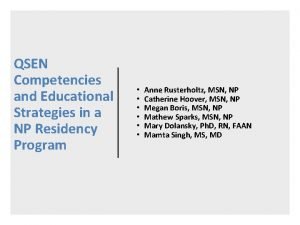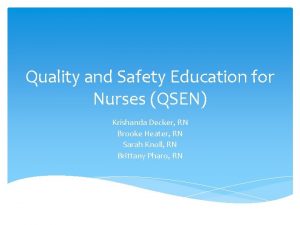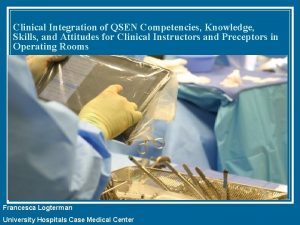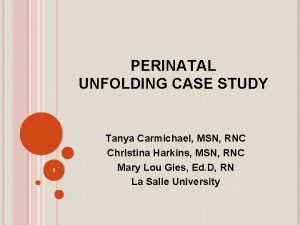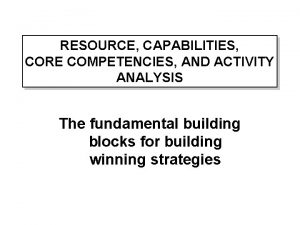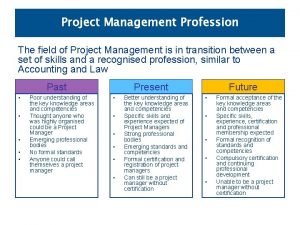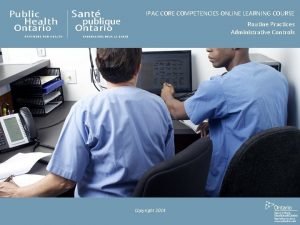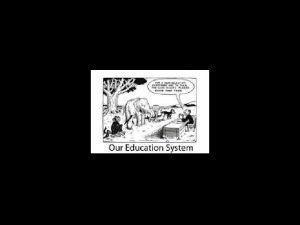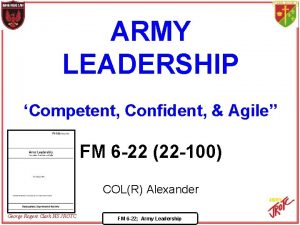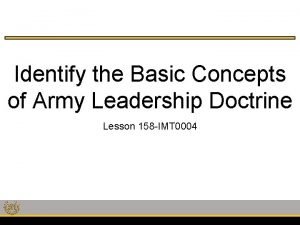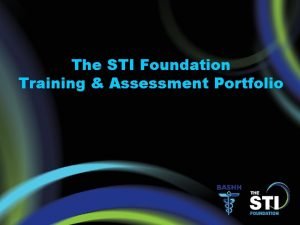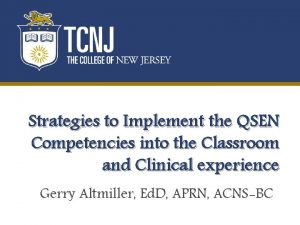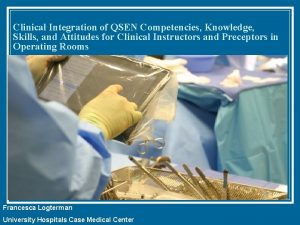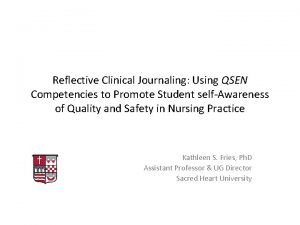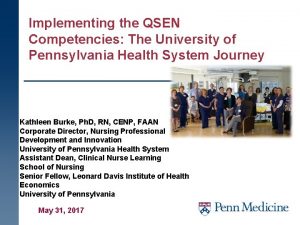QSEN Competencies and Educational Strategies in a NP


























- Slides: 26

QSEN Competencies and Educational Strategies in a NP Residency Program • • • Anne Rusterholtz, MSN, NP Catherine Hoover, MSN, NP Megan Boris, MSN, NP Mathew Sparks, MSN, NP Mary Dolansky, Ph. D, RN, FAAN Mamta Singh, MS, MD

Transforming Out-patient Care (TOPC) Center of Excellence in Primary Education Louis Stokes Veterans Medical Center Cleveland Ohio Funded by the VA Office of Academic Affiliations.

TOPC-COE Mission Our Center’s aim is to “Transform Outpatient Care (TOPC) by empowering physicians, nursing, nurse practitioners, pharmacy, social work and psychology trainees of the 21 st century with skills to effectively lead and participate in patientcentered interprofessional teams that both meet the needs of patients and provider consistent high quality care”.

Develop and test innovative approaches for curricula related to core competencies of patient-centered care. Academic PACT- Center of Excellence (COE) Study the impact of new educational approaches and models on health professions education to include collaboration, cultural shifts in educational priorities, and educational and workforce outcomes within and beyond VA. Improve primary care instructional strategies with emphasis on workplace learning

COE Centers and Academic Affiliates Co-Directors: Mimi Singh, MD, MS and Mary Dolansky, Ph. D, RN Academic Partners: Frances Payne Bolton School of Nursing at Case Western Reserve University Case Western Reserve School of Medicine The Breen School of Nursing at Ursuline College Cleveland Clinic Foundation Co-Directors: C. Scott Smith, MD and Melanie Nash, MSN, ANP Academic Partners: Gonzaga University School of Nursing University of Washington School of Medicine Idaho State University Schools of Pharmacy and Nursing Co-Directors: Rebecca Brienza, MD, MPH and Susan Zapatka, MSN, APN Academic Partners: Fairfield University School of Nursing Quinnipiac University School of Nursing Yale University Schools of Medicine and Nursing University of Connecticut School of Medicine Co-Directors: Joyce Wipf, MD and Kameka Brown, Ph. D, APN Academic Partner: University of Washington Schools of Medicine and Nursing Co-Directors: Rebecca Shunk, MD and Terry Keane, DNP, APN Academic Partner: University of California at San Francisco Schools of Medicine and Nursing

COE Primary Care Education Trainees All sites – Physician residents trainees: Internal Medicine PGY 1, 2, 3, Chief resident – Nurse Practitioner trainees: Pre. Master’s, Pre- Doctorate of Nursing Practice, Post-Master’s residents, Post- Doctorate of Nursing Practice residents – Post-Doctorate Pharmacy residents – Post-Doctorate Psychology fellows Some sites – Social Work – Medical Students – Nutrition/Dietetics – Podiatry – BSN Nursing Students – Physician Assistant

Educational Domains


• • NP Residency in Co. E • One year, full-time, post-graduate degree training – Master’s or DNP degree 60% direct patient care – Panel of patient, prescribing and ordering capacity – Cover rotating medical residents patient panel – Secured messaging 40% indirect patient care – QI projects – Panel management – Journal club, presentations, publications – Precepting in second half of residency

Competencies VA Co. E NP Residency QSEN Clinical Leadership Patient Centered Care Interprofessional Collaboration Teamwork and Collaboration Patient Centered Care Evidence-based Practice Shared Decision Making Informatics Sustained Relationships Quality Improvement Safety Measured at months 1, 3, 6, 9 and 12 10

Entering the Crosswalk Areas of alignment & opportunities for growth

Patient Centered Care: Alignment QSEN Competency NPR Curriculum Exercise Based on active listening to patients, elicit values, preferences and expressed needs as part of interview, diagnosis, implementation of care plan Skilled in using active listening communication techniques Chooses motivational interviewing techniques to help patient change health behaviors Motivational Interviewing Lecture Analyze strategies that empower patients/families in all aspects of the health care process Design a patient centered plan of care… Supports the patient in self management of health Motivational Interviewing Real Time Real Patient Analyze factors that create barriers to patient centered care Respects patient values, preferences, beliefs regarding care Aligning Care Options Simulation Center: Use of MI in simulated patient encounters

Patient Centered Care: Opportunities QSEN competencies Ideas for growth Synthesize critical information about health literacy based on diversity of patient population. Create curriculum to educate learners on tools to assess patient health literacy Analyze ethical and legal implications of patient-centered care Encourage more discussion with ethics experts in didactic discussion as well as in clinical situations (i. e. consult ethics committee) Coach learners on how to approach goals of care discussions and documentation

Teamwork & Collaboration: Alignment QSEN Competency NPR Curriculum Exercise Analyze self & other team members’ strengths, limitations & values Develop PACT team huddles Leading PACT team huddle, understanding role of team member scope of practice and utilizing team member skills appropriately to enhance patient care Describe appropriate handoff communication practices Demonstrate skill in safely transitioning patients among PACT team Team. STEPPS Transitions in Care lecture Analyze strategies for identifying & managing overlap in team roles & accountabilities Elicit team member input to improve performance Demonstrates interest in developing respectful & trusting relationship with PACT team, clinic faculty, mentors, peer trainees & staff Team. STEPPS: Situation monitoring Aligning Care Options

Teamwork & Collaboration: Opportunities QSEN competencies Ideas for growth Function competently within own scope of practice as a member of the health care team Deliver presentation in didactic or provider series to educate PACT team members on the NP scope of practice Analyze authority gradients and their influence on teamwork and patient safety Crucial Conversations: Focus on enhancing use of crucial conversation techniques when working with authority figures (i. e. attending providers)

Evidence Based Practice: Alignment QSEN Competency NPR Curriculum Example Summarize current evidence regarding major diagnostic & treatment actions within the practice specialty & health delivery system Prepares at least one evidence – based journal club discussion on primary care topic APN series Provider series: journal club Clinic Huddles: - EBM “Pearl” Exhibit contemporary knowledge of best evidence related to practice Opportunity for competency APN series Yale modules Evidence Based Medicine didactic session Analyze how strength of evidence influences care Employs health care Journal Club prevention with the patient EBP didactic session and patient panel Panel management

Evidence Based Practice: Opportunities QSEN competencies Ideas for growth Exhibit contemporary knowledge of best evidence related to practice Create competency to reflect the residency’s rich EBP curriculum Promote a research agenda for evidence that is needed in practice specialty Expose NPRs to the IRB process and consider opportunities for involvement in research projects Use coaching skills to engage nurses in EBP and research Engage PACT team in didactic learning sessions

Quality Improvement: Alignment QSEN Competency NPR Curriculum Exercise Select & use QI improvement tools to achieve best possible outcomes Carry out PDSA cycles Design a QI project for the primary care environment Primary care focused quality improvement project Participate in analysis of databases as sources of information for improving patient care. Organize a system to track and review a panel of patients longitudinally to meet their health care needs. Utilize chronic disease registry to plan and implement panel management activities Describe strategies for improving outcomes at all care points Employs effective leadership skills to coordinate PACT team improvement projects Lean Six Sigma training PACT clinic QI projects

Quality improvement: Opportunities QSEN skill Idea Use public reporting information to advance quality improvement efforts Encourage veteran participation and/or feedback in quality improvement projects and PDSA cycles Participate in design and monitoring of Incorporate education on difference ethical oversight of quality between quality improvement, improvement projects research and IRB oversight

Informatics: Alignment QSEN Competency NPR Curriculum Example Identify the critical and useful electronic data needed to provide quality, efficient care Organize a longitudinal system to track & review patient care needs Appraise individual & panel performance data Utilizing chronic disease registry data to implement panel management activities Telehealth Understand how technology can be used to engage & empower patients as partners in managing care Practice nontraditional approaches to coordinate patient communication between visits My. Healthy. Vet Secure messaging Social Media/Electronic communication lecture

Informatics: Opportunities QSEN competency Ideas for growth Utilize systems that do not rely on memory Integrate CMT tracker into PACT team practice and huddles to facilitate follow up on patient-centered plan of care Understand how technology can be Train learners how to use My used to engage and empower patients Healthy. Vet system and messaging as partners in managing their own care. Participate in the selection, design, implementation, and evaluation of information systems Encourage learners to provide feedback to improve EMR and other VA systems

Safety: Alignment QSEN Competency NPR Curriculum Example Identify best practices that promote patient, community and provider safety in the practice setting Acknowledges mentoring relationship feedback for continuous development Weekly mentor meeting Identify effective strategies Demonstrates skill in safely Transitions in Care to promote a high transitioning patients RCA reliability organization among PACT team Team. Stepps members and specialty care for panel management Identify process used to Is skillful in performing root RCA opportunities analyze causes of error and cause analysis with a reflection allocation of responsibility critical incident and accountability

Safety: Opportunities QSEN skill Idea Identify best practices that promote patient, community, and provider safety in the practice setting Integrate M&M into didactic curriculum Diagnostic opportunities log – review of diagnostic errors Report errors and support members of Reflection root-cause analysis journal the health care team to be and follow up discussions forthcoming about errors and near misses

Completing the Crosswalk: Next Steps • Identified areas of strength: – Patient Centered Care – Teamwork & Collaboration – Quality Improvement – Evidence-Based Practice • Revise NPR competencies & curriculum to enhance areas of opportunity • Discuss findings with Curriculum Manager/Fidelity Manager (CMFM) committee – Develop new curricula to address deficits

References • Flinter, M. (2011). From new nurse practitioner to primary care provider: bridging the transition through FQHC-based residency training. The Online Journal of Nursing Issues, 17(1). • Gilman, S. C. , Chokshi, D. A. , Bowen, J. L. , Rugen, K. W. & Cox, M. (2014). Connecting the Dots: Health professions education and delivery system redesign. Academic Medicine 89(8), 1113 -1118. • Lyle-Eldrosolo, G. L. (2016). Aligning healthcare safety and quality competencies: Quality and Safety Education for Nurses (QSEN), The Joint Commission, and American Nurses Credentialing Center (ANCC) Magnet® Standards Crosswalk. Nurse Leader • Rugen KW, Watts SA, Janson SL, Angelo LA, Nash M, Zapatka SA, Brienza R, Gilman SC, Bowen JL, Saxe JM. Veteran Affairs Centers of Excellence in Primary Care Education: Transforming nurse practicioner education • Rugen, K. W. , Speroff, E. , Zapatka, S. A. & Brienza, R. (2016). Veterans Affairs interprofessional nurse practitioner residency in primary care: A competency based program. The Journal for Nurse Practitioners, 12(6), e 267 -273. • Zapatka, S. A. , Conelius, J. , Edwards, J. Meyer, E. & Brienza, R. (2014). Pioneering a primary care adult nurse practitioner interprofessional fellowship. The Journal for Nurse Practitioners, 10(6), 378 -386.

Thank you! Questions? ?
 Qsen competencies
Qsen competencies Qsen competencies
Qsen competencies Qsen patient-centered care examples
Qsen patient-centered care examples Qsen competencies
Qsen competencies Qsen competency
Qsen competency What is qsen
What is qsen Qsen teamwork and collaboration
Qsen teamwork and collaboration Quality safety education for nurses
Quality safety education for nurses Qsen competency safety
Qsen competency safety Qsen
Qsen Qsen simulation rubric
Qsen simulation rubric Tanya carmichael
Tanya carmichael Resources and competencies analysis
Resources and competencies analysis Pmo skills and competencies
Pmo skills and competencies Ipac course online
Ipac course online Unit standards and competencies diagram
Unit standards and competencies diagram Community linkages and professional engagement importance
Community linkages and professional engagement importance Competencies and attributes
Competencies and attributes Fm 6-22 army leadership
Fm 6-22 army leadership Business analyst skills and competencies
Business analyst skills and competencies Professional strand
Professional strand Army lrm
Army lrm Meaning and nature of education
Meaning and nature of education Competent listening
Competent listening Unifrog competencies
Unifrog competencies Sti foundation
Sti foundation Leadership architect competencies
Leadership architect competencies




